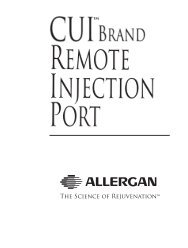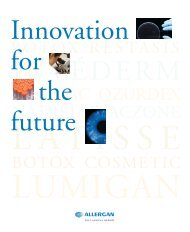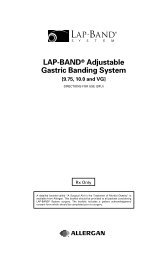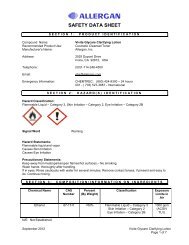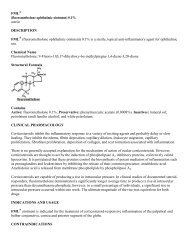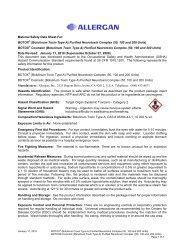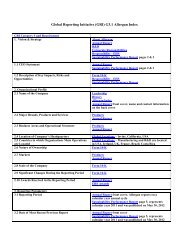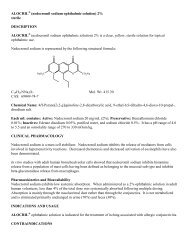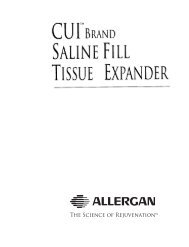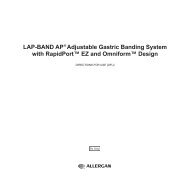ACZONE® Prescribing Information - Allergan
ACZONE® Prescribing Information - Allergan
ACZONE® Prescribing Information - Allergan
- No tags were found...
You also want an ePaper? Increase the reach of your titles
YUMPU automatically turns print PDFs into web optimized ePapers that Google loves.
HIGHLIGHTS OF PRESCRIBING<br />
INFORMATION<br />
These highlights do not include all the information<br />
needed to use ACZONE ® safely and effectively.<br />
See full prescribing information for ACZONE ® .<br />
ACZONE ® (dapsone) Gel, 5%<br />
For topical use only<br />
Initial U.S. Approval: 1955<br />
_________ INDICATIONS AND USAGE<br />
_________<br />
ACZONE ® Gel is indicated for the topical treatment<br />
of acne vulgaris (1).<br />
______ DOSAGE AND ADMINISTRATION<br />
______<br />
• Apply twice daily (2).<br />
• Apply approximately a pea-sized amount of<br />
ACZONE ® Gel, 5%, in a thin layer to the acne<br />
affected area (2).<br />
• If there is no improvement after 12 weeks, treatment<br />
with ACZONE ® Gel, 5%, should be reassessed (2).<br />
For topical use only. Not for oral, ophthalmic, or<br />
intravaginal use (2).<br />
_____ DOSAGE FORMS AND STRENGTHS<br />
_____<br />
ACZONE ® (dapsone) Gel, 5%, is supplied in the<br />
following size tubes:<br />
• Professional Sample: 3 gram laminate tube (3).<br />
• Commercially: 30, 60, and 90 gram laminate tubes<br />
(3).<br />
__________ CONTRAINDICATIONS<br />
___________<br />
None.<br />
______ WARNINGS AND PRECAUTIONS<br />
______<br />
Hematological Effects: Some subjects with G6PD<br />
deficiency using ACZONE ® Gel developed laboratory<br />
changes suggestive of mild hemolysis (5.1)(8.6).<br />
The following are seen with oral dapsone treatment:<br />
• Hematological Effects (5.1).<br />
• Peripheral Neuropathy (5.2).<br />
• Skin Reactions (5.3).<br />
___________ ADVERSE REACTIONS<br />
___________<br />
Most common adverse reactions (incidence ≥ 10%)<br />
are oiliness/peeling, dryness and erythema at the<br />
application site (6).<br />
To report SUSPECTED ADVERSE REACTIONS,<br />
contact <strong>Allergan</strong> at 1-800-433-8871 or FDA at<br />
1-800-FDA-1088 or www.fda.gov/medwatch.<br />
___________ DRUG INTERACTIONS<br />
___________<br />
• Trimethoprim/sulfamethoxazole (TMP/SMX)<br />
increases the level of dapsone and its metabolites<br />
(7.1).<br />
• Topical benzoyl peroxide used at the same time as<br />
ACZONE ® may result in temporary local yellow or<br />
orange skin discoloration (7.2).<br />
______ USE IN SPECIFIC POPULATIONS<br />
______<br />
G6PD Deficiency (8.6).<br />
See 17 for PATIENT COUNSELING<br />
INFORMATION and FDA-approved patient<br />
labeling.<br />
Revised: 03/2013
FULL PRESCRIBING INFORMATION:<br />
CONTENTS*<br />
1 INDICATIONS AND USAGE<br />
2 DOSAGE AND ADMINISTRATION<br />
3 DOSAGE FORMS AND STRENGTHS<br />
4 CONTRAINDICATIONS<br />
5 WARNINGS AND PRECAUTIONS<br />
5.1 Hematological Effects<br />
5.2 Peripheral Neuropathy<br />
5.3 Skin<br />
6 ADVERSE REACTIONS<br />
6.1 Clinical Studies Experience<br />
6.2 Experience with Oral Use of Dapsone<br />
7 DRUG INTERACTIONS<br />
7.1 Trimethoprim-Sulfamethoxazole<br />
7.2 Topical Benzoyl Peroxide<br />
7.3 Drug Interactions with Oral Dapsone<br />
8 USE IN SPECIFIC POPULATIONS<br />
8.1 Pregnancy<br />
8.3 Nursing Mothers<br />
8.4 Pediatric Use<br />
8.5 Geriatric Use<br />
8.6 G6PD Deficiency<br />
10 OVERDOSAGE<br />
11 DESCRIPTION<br />
12 CLINICAL PHARMACOLOGY<br />
12.1 Mechanism of Action<br />
12.3 Pharmacokinetics<br />
12.4 Microbiology<br />
13 NONCLINICAL TOXICOLOGY<br />
13.1 Carcinogenesis, Mutagenesis,<br />
Impairment of Fertility<br />
14 CLINICAL STUDIES<br />
16 HOW SUPPLIED/STORAGE AND<br />
HANDLING<br />
17 PATIENT COUNSELING INFORMATION<br />
17.1 <strong>Information</strong> for Patients<br />
17.2 FDA-Approved Patient Labeling<br />
* Sections or subsections omitted from the full<br />
prescribing information are not listed.<br />
FULL PRESCRIBING INFORMATION<br />
1 INDICATIONS AND USAGE<br />
ACZONE ® Gel, 5%, is indicated for the topical treatment of acne vulgaris.<br />
2 DOSAGE AND ADMINISTRATION<br />
For topical use only. Not for oral, ophthalmic, or intravaginal use.<br />
After the skin is gently washed and patted dry, apply approximately a pea-sized amount of ACZONE ® Gel, 5%,<br />
in a thin layer to the acne affected areas twice daily. Rub in ACZONE ® Gel, 5%, gently and completely.<br />
ACZONE ® Gel, 5%, is gritty with visible drug substance particles. Wash hands after application of ACZONE ®<br />
Gel, 5%.<br />
If there is no improvement after 12 weeks, treatment with ACZONE ® Gel, 5%, should be reassessed.<br />
3 DOSAGE FORMS AND STRENGTHS<br />
ACZONE ® (dapsone) Gel, 5%, is supplied in the following size tubes:<br />
Ÿ Professional Sample: 3 gram laminate tube<br />
Ÿ Commercially: 30, 60, and 90 gram laminate tubes<br />
4 CONTRAINDICATIONS<br />
None.<br />
5 WARNINGS AND PRECAUTIONS<br />
5.1 Hematological Effects<br />
Oral dapsone treatment has produced dose-related hemolysis and hemolytic anemia. Individuals with glucose-6-<br />
phosphate dehydrogenase (G6PD) deficiency are more prone to hemolysis with the use of certain drugs. G6PD<br />
deficiency is most prevalent in populations of African, South Asian, Middle Eastern, and Mediterranean<br />
ancestry.
There was no evidence of clinically relevant hemolysis or anemia in patients treated with ACZONE ® Gel, 5%,<br />
including patients who were G6PD deficient. Some subjects with G6PD deficiency using ACZONE ® Gel<br />
developed laboratory changes suggestive of mild hemolysis.<br />
If signs and symptoms suggestive of hemolytic anemia occur, ACZONE ® Gel, 5% should be discontinued.<br />
ACZONE ® Gel, 5% should not be used in patients who are taking oral dapsone or antimalarial medications<br />
because of the potential for hemolytic reactions. Combination of ACZONE ® Gel, 5%, with<br />
trimethoprim/sulfamethoxazole (TMP/SMX) may increase the likelihood of hemolysis in patients with G6PD<br />
deficiency.<br />
5.2 Peripheral Neuropathy<br />
Peripheral neuropathy (motor loss and muscle weakness) has been reported with oral dapsone treatment. No<br />
events of peripheral neuropathy were observed in clinical trials with topical ACZONE ® Gel, 5% treatment.<br />
5.3 Skin<br />
Skin reactions (toxic epidermal necrolysis, erythema multiforme, morbilliform and scarlatiniform reactions,<br />
bullous and exfoliative dermatitis, erythema nodosum, and urticaria) have been reported with oral dapsone<br />
treatment. These types of skin reactions were not observed in clinical trials with topical ACZONE ® Gel, 5%<br />
treatment.<br />
6 ADVERSE REACTIONS<br />
6.1 Clinical Studies Experience<br />
Because clinical trials are conducted under prescribed conditions, adverse reaction rates observed in the clinical<br />
trials of a drug cannot be directly compared to rates in the clinical trials of another drug and may not reflect the<br />
rates observed in practice.<br />
Serious adverse reactions reported in patients treated with ACZONE ® Gel, 5%, during clinical trials included<br />
but were not limited to the following:<br />
Ÿ Nervous system/Psychiatric – Suicide attempt, tonic clonic movements.<br />
Ÿ Gastrointestinal – Abdominal pain, severe vomiting, pancreatitis.<br />
Ÿ Other – Severe pharyngitis<br />
In the clinical trials, a total of 12 out of 4032 patients were reported to have depression (3 of 1660 treated with<br />
vehicle and 9 of 2372 treated with ACZONE ® Gel, 5%). Psychosis was reported in 2 of 2372 patients treated<br />
with ACZONE ® Gel, 5%, and in 0 of 1660 patients treated with vehicle.<br />
Combined contact sensitization/irritation studies with ACZONE ® Gel, 5%, in 253 healthy subjects resulted in<br />
at least 3 subjects with moderate erythema. ACZONE ® Gel, 5%, did not induce phototoxicity or photoallergy<br />
in human dermal safety studies.<br />
ACZONE ® Gel, 5%, was evaluated for 12 weeks in four controlled studies for local cutaneous events in 1819<br />
patients. The most common events reported from these studies include oiliness/peeling, dryness, and erythema.<br />
These data are shown by severity in Table 1 below.
Table 1 – Application Site Adverse Reactions by Maximum Severity<br />
ACZONE ®<br />
(N=1819)<br />
Vehicle<br />
(N=1660)<br />
Application Site Event Mild Moderate Severe Mild Moderate Severe<br />
Erythema 9% 5%
(AUC 0-12 ) of dapsone hydroxylamine (DHA) was more than doubled in the presence of TMP/SMX. Exposure<br />
from the proposed topical dose is about 1% of that from the 100 mg oral dose, even when co-administered with<br />
TMP/SMX.<br />
7.2 Topical Benzoyl Peroxide<br />
Topical application of ACZONE ® Gel followed by benzoyl peroxide in subjects with acne vulgaris resulted in a<br />
temporary local yellow or orange discoloration of the skin and facial hair (reported by 7 out of 95 subjects in a<br />
clinical study) with resolution in 4 to 57 days.<br />
7.3 Drug Interactions with Oral Dapsone<br />
Certain concomitant medications (such as rifampin, anticonvulsants, St. John’s wort) may increase the<br />
formation of dapsone hydroxylamine, a metabolite of dapsone associated with hemolysis. With oral dapsone<br />
treatment, folic acid antagonists such as pyrimethamine have been noted to possibly increase the likelihood of<br />
hematologic reactions.<br />
8 USE IN SPECIFIC POPULATIONS<br />
8.1 Pregnancy<br />
Teratogenic Effects: Pregnancy Category C<br />
There are no adequate and well controlled studies in pregnant women. Dapsone has been shown to have an<br />
embryocidal effect in rats and rabbits when administered orally in doses of 75 mg/kg/day and 150 mg/kg/day<br />
(approximately 800 and 500 times the systemic exposure observed in human females as a result of use of the<br />
maximum recommended topical dose, based on AUC comparisons), respectively. These effects were probably<br />
secondary to maternal toxicity. ACZONE ® Gel, 5%, should be used during pregnancy only if the potential<br />
benefit justifies the potential risk to the fetus.<br />
8.3 Nursing Mothers<br />
Although systemic absorption of dapsone following topical application of ACZONE ® Gel, 5%, is minimal<br />
relative to oral dapsone administration, it is known that dapsone is excreted in human milk. Because of the<br />
potential for oral dapsone to cause adverse reactions in nursing infants, a decision should be made whether to<br />
discontinue nursing or to discontinue ACZONE ® Gel, 5%, taking into account the importance of the drug to the<br />
mother.<br />
8.4 Pediatric Use<br />
Safety and efficacy was evaluated in 1169 children aged 12-17 years old treated with ACZONE ® Gel, 5%, in<br />
the clinical studies. The adverse event rate for ACZONE ® Gel, 5%, was similar to the vehicle control group.<br />
Safety and efficacy was not studied in pediatric patients less than 12 years of age, therefore ACZONE ® Gel,<br />
5%, is not recommended for use in this age group.<br />
8.5 Geriatric Use<br />
Clinical studies of ACZONE ® Gel, 5%, did not include sufficient number of patients aged 65 and over to<br />
determine whether they respond differently from younger patients.<br />
8.6 G6PD Deficiency<br />
ACZONE ® Gel, 5% and vehicle were evaluated in a randomized, double-blind, cross-over design clinical study<br />
of 64 patients with G6PD deficiency and acne vulgaris. Subjects were Black (88%), Asian (6%), Hispanic (2%)<br />
or of other racial origin (5%). Blood samples were taken at Baseline, Week 2, and Week 12 during both vehicle<br />
and ACZONE ® Gel, 5% treatment periods. There were 56 out of 64 subjects who had a Week 2 blood draw and<br />
applied at least 50% of treatment applications. Table 3 contains results from testing of relevant hematology<br />
parameters for these two treatment periods. ACZONE ® Gel was associated with a 0.32 g/dL drop in<br />
hemoglobin after two weeks of treatment, but hemoglobin levels generally returned to baseline levels at Week<br />
12.
Table 3 – Mean Hemoglobin, Bilirubin, and Reticulocyte Levels in Acne Subjects with G6PD Deficiency<br />
in ACZONE ® /Vehicle Cross-Over Study<br />
ACZONE ® Vehicle<br />
N Mean N Mean<br />
Hemoglobin (g/dL) Pre-treatment 53 13.44 56 13.36<br />
2 weeks 53 13.12 55 13.34<br />
12 weeks 50 13.42 50 13.37<br />
Bilirubin (mg/dL) Pre-treatment 54 0.58 56 0.55<br />
2 weeks 53 0.65 55 0.56<br />
12 weeks 50 0.61 50 0.62<br />
Reticulocytes (%) Pre-treatment 53 1.30 55 1.34<br />
2 weeks 53 1.51 55 1.34<br />
12 weeks 50 1.48 50 1.41<br />
There were no changes from baseline in haptoglobin or lactate dehydrogenase during ACZONE ® or vehicle<br />
treatment at either the 2-week or 12-week time point.<br />
The proportion of subjects who experienced decreases in hemoglobin ≥1 g/dL was similar between ACZONE ®<br />
Gel, 5% and vehicle treatment (8 of 58 subjects had such decreases during ACZONE ® treatment compared to 7<br />
of 56 subjects during vehicle treatment among subjects with at least one on-treatment hemoglobin assessment).<br />
Subgroups based on gender, race, or G6PD enzyme activity did not display any differences in laboratory results<br />
from the overall study group. There was no evidence of clinically significant hemolytic anemia in this study.<br />
Some of these subjects developed laboratory changes suggestive of mild hemolysis.<br />
10 OVERDOSAGE<br />
ACZONE ® Gel, 5%, is not for oral use. If oral ingestion occurs, medical advice should be sought.<br />
11 DESCRIPTION<br />
ACZONE ® Gel, 5%, contains dapsone, a sulfone, in an aqueous gel base for topical dermatologic use.<br />
ACZONE ® Gel, 5% is a gritty translucent material with visible drug substance particles. Chemically,<br />
dapsone has an empirical formula of C 12 H 12 N 2 O 2 S. It is a white, odorless crystalline powder that has a<br />
molecular weight of 248. Dapsone’s chemical name is 4,4’-diaminodiphenylsulfone and its structural formula<br />
is:<br />
Each gram of ACZONE ® Gel, 5%, contains 50 mg of dapsone, USP, in a gel of carbomer homopolymer type<br />
C; diethylene glycol monoethyl ether, NF; methylparaben, NF; sodium hydroxide, NF; and purified water, USP.<br />
12 CLINICAL PHARMACOLOGY<br />
12.1 Mechanism of Action<br />
The mechanism of action of dapsone gel in treating acne vulgaris is not known.<br />
12.3 Pharmacokinetics<br />
An open-label study compared the pharmacokinetics of dapsone after ACZONE ® Gel, 5%, (110 ± 60 mg/day)<br />
was applied twice daily (~BSA 22.5%) for 14 days (n=18) with a single 100 mg dose of oral dapsone<br />
administered to a subgroup of patients (n=10) in a crossover design. On Day 14 the mean dapsone AUC 0-24h was<br />
415 ± 224 ng•h/mL for ACZONE ® Gel, 5%, whereas following a single 100 mg dose of oral dapsone the<br />
AUC 0-infinity was 52,641 ± 36,223 ng•h/mL. Exposure after the oral dose of 100 mg dapsone was approximately<br />
100 times greater than after the topical ACZONE ® Gel, 5% dose, twice a day.
In a long-term safety study of ACZONE ® Gel, 5% treatment, periodic blood samples were collected up to 12<br />
months to determine systemic exposure of dapsone and its metabolites in approximately 500 patients. Based on<br />
the measurable dapsone concentrations from 408 patients (M=192, F=216), obtained at month 3, neither gender,<br />
nor race appeared to affect the pharmacokinetics of dapsone. Similarly, dapsone exposures were approximately<br />
the same between the age groups of 12-15 years (N=155) and those greater than or equal to 16 years (N=253).<br />
There was no evidence of increasing systemic exposure to dapsone over the study year in these patients.<br />
12.4 Microbiology<br />
In Vivo Activity: No microbiology or immunology studies were conducted during dapsone gel clinical trials.<br />
Drug Resistance: No dapsone resistance studies were conducted during dapsone gel clinical trials. Because no<br />
microbiology studies were done, there are no data available as to whether dapsone treatment may have resulted<br />
in decreased susceptibility of Propionibacterium acnes, an organism associated with acne, to other<br />
antimicrobials that may be used to treat acne. Therapeutic resistance to dapsone has been reported for<br />
Mycobacterium leprae, when patients have been treated with oral dapsone.<br />
13 NONCLINICAL TOXICOLOGY<br />
13.1 Carcinogenesis, Mutagenesis, Impairment of Fertility<br />
Dapsone was not mutagenic in a bacterial reverse mutation assay (Ames test) using S. typhimurium and E. coli,<br />
with and without metabolic activation and was negative in a micronucleus assay conducted in mice. Dapsone<br />
increased both numerical and structural aberrations in a chromosome aberration assay conducted with Chinese<br />
hamster ovary (CHO) cells.<br />
Dapsone was not carcinogenic to rats when orally administered to females for 92 weeks or males for 100 weeks<br />
at dose levels up to 15 mg/kg/day (approximately 160 times the systemic exposure observed in human males<br />
and 300 times the systemic exposure observed in human females as a result of use of the maximum<br />
recommended topical dose, based on AUC comparisons).<br />
No evidence of potential to induce carcinogenicity was obtained in a dermal study in which dapsone gel was<br />
topically applied to Tg.AC transgenic mice for approximately 26 weeks. Dapsone concentrations of 3%, 5%,<br />
and 10% were evaluated; 3% material was judged to be the maximum tolerated dosage.<br />
ACZONE ® Gel, 5%, did not increase the rate of formation of ultraviolet light-induced skin tumors when<br />
topically applied to hairless mice in a 12-month photocarcinogenicity study.<br />
The effects of dapsone on fertility and general reproduction performance were assessed in male and female rats<br />
following oral (gavage) dosing. Dapsone reduced sperm motility at dosages of 3 mg/kg/day or greater<br />
(approximately 17 times the systemic exposure observed in human males as a result of use of the maximum<br />
recommended topical dose, based on AUC comparisons). The mean numbers of embryo implantations and<br />
viable embryos were significantly reduced in untreated females mated with males that had been dosed at 12<br />
mg/kg/day or greater (approximately 70 times the systemic exposure observed in human males as a result of use<br />
of the maximum recommended topical dose, based on AUC comparisons), presumably due to reduced numbers<br />
or effectiveness of sperm, indicating impairment of fertility. Dapsone had no effect on male fertility at dosages<br />
of 2 mg/kg/day or less (approximately 13 times the systemic exposure observed in human males as a result<br />
of use of the maximum recommended topical dose, based on AUC comparisons). When administered to female<br />
rats at a dosage of 75 mg/kg/day (approximately 800 times the systemic exposure observed in human females as<br />
a result of use of the maximum recommended topical dose, based on AUC comparisons) for 15 days prior to<br />
mating and for 17 days thereafter, dapsone reduced the mean number of implantations, increased the mean early<br />
resorption rate, and reduced the mean litter size. These effects were probably secondary to maternal toxicity.<br />
Dapsone was assessed for effects on perinatal/postnatal pup development and postnatal maternal behavior and<br />
function in a study in which dapsone was orally administered to female rats daily beginning on the seventh day
of gestation and continuing until the twenty-seventh day postpartum. Maternal toxicity (decreased body weight<br />
and food consumption) and developmental effects (increase in stillborn pups and decreased pup weight) were<br />
seen at a dapsone dose of 30 mg/kg/day (approximately 500 times the systemic exposure observed in human<br />
females as a result of use of the maximum recommended topical dose, based on AUC comparisons). No effects<br />
were observed on the viability, physical development, behavior, learning ability, or reproductive function of<br />
surviving pups.<br />
14 CLINICAL STUDIES<br />
Two randomized, double-blind, vehicle-controlled, clinical studies were conducted to evaluate ACZONE ® Gel,<br />
5%, for the treatment of patients with acne vulgaris (N=1475 and 1525). The studies were designed to enroll<br />
patients 12 years of age and older with 20 to 50 inflammatory and 20 to 100 non-inflammatory lesions at<br />
baseline. In these studies patients applied either ACZONE ® Gel, 5%, or vehicle control twice daily for up to 12<br />
weeks. Efficacy was evaluated in terms of success on the Global Acne Assessment Score (no or minimal acne)<br />
and in the percent reduction in inflammatory, non-inflammatory, and total lesions.<br />
The Global Acne Assessment Score was a 5-point scale as follows:<br />
0 None: no evidence of facial acne vulgaris<br />
1 Minimal: few non-inflammatory lesions (comedones) are present; a few inflammatory lesions<br />
(papules/pustules) may be present<br />
2 Mild: several to many non-inflammatory lesions (comedones) are present; a few inflammatory lesions<br />
(papules/pustules) are present<br />
3 Moderate: many non-inflammatory (comedones) and inflammatory lesions (papules/pustules) are present; no<br />
nodulo-cystic lesions are allowed<br />
4 Severe: significant degree of inflammatory disease; papules/pustules are a predominant feature; a few<br />
nodulo-cystic lesions may be present; comedones may be present.<br />
The success rates on the Global Acne Assessment Score (no or minimal acne) at Week 12 are presented in<br />
Table 4.<br />
Table 4 - Success (No or Minimal Acne) on the Global Acne Assessment Score at Week 12<br />
Study 1* Study 2*<br />
ACZONE ®<br />
N=699<br />
Vehicle<br />
N=687<br />
ACZONE ®<br />
N=729<br />
Vehicle<br />
N=738<br />
Subjects with No or Minimal Acne 291 (42%) 223 (32%) 253 (35%) 206 (28%)<br />
*Analysis excludes subjects classified with minimal acne at baseline<br />
Table 5 presents the mean percent reduction in inflammatory, non-inflammatory, and total lesions from baseline<br />
to Week 12.
Table 5 - Percent Reduction in Lesions from Baseline to Week 12<br />
Study 1 Study 2<br />
ACZONE ®<br />
N=745<br />
Vehicle<br />
N=740<br />
ACZONE ®<br />
N=761<br />
Vehicle<br />
N=764<br />
Inflammatory 46% 42% 48% 40%<br />
Non-Inflammatory 31% 24% 30% 21%<br />
Total 38% 32% 37% 29%<br />
The clinical studies enrolled about equal proportions of male and female subjects. Female patients tended to<br />
have greater percent reductions in lesions and greater success on the Global Acne Assessment Score than males.<br />
The breakdown by race in the clinical studies was about 73% Caucasian, 14% Black, 9% Hispanic, and 2%<br />
Asian. Efficacy results were similar across the racial subgroups.<br />
16 HOW SUPPLIED/STORAGE AND HANDLING<br />
ACZONE ® (dapsone) Gel, 5%, is supplied in the following size tubes:<br />
Professional Sample<br />
5% NDC 0023-3670-03<br />
3 gram laminate tube<br />
Commercially Available as:<br />
5% NDC 0023-3670-30<br />
30 gram laminate tube<br />
5% NDC 0023-3670-60<br />
60 gram laminate tube<br />
5% NDC 0023-3670-90<br />
90 gram laminate tube<br />
KEEP OUT OF THE REACH OF CHILDREN LESS THAN 12 YEARS OLD.<br />
Storage conditions:<br />
Store at controlled room temperature, 20°-25°C (68°-77°F), excursions permitted to 15°-30ºC (59°-86ºF).<br />
Protect from freezing.<br />
17 PATIENT COUNSELING INFORMATION<br />
See FDA-Approved Patient Labeling (17.2)<br />
17.1 <strong>Information</strong> for Patients<br />
1. Patients should use ACZONE ® Gel, 5%, as directed by the physician. ACZONE ® Gel, 5%, is for<br />
external topical use only. ACZONE ® Gel, 5%, is not for oral, ophthalmic or intravaginal use.<br />
2. Patients should not use this medication for any disorder other than that for which it was prescribed.<br />
3. Patients should report any signs of adverse reactions to their physician.<br />
4. Protect ACZONE ® Gel, 5%, from freezing.<br />
5. See Patient Labeling for additional information on safety, efficacy, general use, and storage of<br />
ACZONE ® Gel, 5%.<br />
-------Cut Here " ----------------------------------------------------------------------------------------------------------------
17.2 FDA-Approved Patient Labeling<br />
ACZONE ® (dapsone) Gel 5%<br />
Read this important information before you start using ACZONE ® (AK-zōn) Gel and each time you refill your<br />
prescription. There may be new information that you need to know. This summary is not meant to take the place<br />
of your doctor’s advice. If you have any questions or want more information about ACZONE ® Gel, ask your<br />
doctor or pharmacist.<br />
What is ACZONE ® Gel<br />
ACZONE ® Gel is a prescription medicine used on your skin (topical) to treat acne in people 12 years and older.<br />
ACZONE ® Gel has not been studied in children under 12 years of age.<br />
Who should not use ACZONE ® Gel<br />
Do not use ACZONE ® Gel if you are allergic to any of the ingredients in ACZONE ® Gel or if you are younger<br />
than 12 years of age.<br />
Active ingredient: dapsone.<br />
Inactive ingredients: Carbomer homopolymer type C, diethylene glycol monoethyl ether (DGME),<br />
methylparaben, sodium hydroxide, and purified water.<br />
What should I tell my doctor before using ACZONE ® Gel<br />
Tell your doctor about all of your medical conditions, including if you:<br />
• are pregnant or planning to become pregnant. It is not known if ACZONE ® Gel may harm your unborn<br />
baby. You and your doctor will need to decide if ACZONE ® is right for you.<br />
• are breastfeeding. ACZONE ® Gel passes into your milk and may harm your baby. You should choose<br />
either to use ACZONE ® Gel, or breastfeed, but not both. Talk to your doctor about the best way to feed<br />
your baby while using ACZONE ® Gel.<br />
• have glucose-6-phosphate dehydrogenase deficiency.<br />
Tell your doctor about all the medicines you are taking including prescription and nonprescription<br />
medicines, vitamins and herbal supplements. Especially, tell your doctor if you are using any other medicines<br />
applied to the skin, such as acne medicines with benzoyl peroxide.<br />
How do I use ACZONE ® Gel<br />
• Use ACZONE ® Gel exactly as prescribed by your doctor. ACZONE ® Gel is usually used on your affected<br />
skin twice a day, once in the morning and once in the evening.<br />
• Wash the areas of your skin where you will apply ACZONE ® Gel. Gently pat your skin dry with a clean<br />
towel.<br />
• Apply a thin layer of ACZONE ® Gel to the areas of your skin that have acne. A pea-sized amount of<br />
ACZONE ® Gel will usually be enough.<br />
• Rub the medicine in gently and completely.<br />
• Make sure to put the cap back on the ACZONE ® Gel tube. Close it tightly.<br />
• Wash your hands after applying ACZONE ® Gel.<br />
• Keep ACZONE ® Gel away from your mouth and eyes. Do not swallow ACZONE ® Gel. If you swallow<br />
ACZONE ® Gel, call your doctor or poison control center right away.<br />
• If your acne does not get better after using ACZONE ® Gel for 12 weeks, talk to your doctor about other<br />
treatments for acne.<br />
What are the possible side effects of ACZONE ® Gel
Like all medicines, ACZONE ® Gel can cause some side effects. The most common side effects of ACZONE ®<br />
Gel are dryness, redness, oiliness and peeling of the skin being treated.<br />
When the active ingredient of ACZONE ® Gel (called dapsone) is taken orally as a pill, it has been related to the<br />
abnormal breakdown of red blood cells (hemolytic anemia). If you have glucose-6-phosphate dehydrogenase<br />
deficiency, you may have a greater risk for lowering your hemoglobin level. However, using ACZONE ® Gel<br />
on the skin is not expected to put enough dapsone in the blood to cause clinical symptoms of hemolytic anemia.<br />
You are advised to be alert for signs and symptoms suggestive of this type of anemia (sudden onset of: back<br />
pain, breathlessness, tiredness/weakness with daily activities, dark-brown urine, high fever and yellow or pale<br />
skin). If you experience these signs and symptoms, stop use and call your doctor immediately.<br />
Use of benzoyl peroxide together with ACZONE ® Gel at the same time may cause your skin to temporarily<br />
turn yellow or orange at the site of application.<br />
This is not a complete list of all the possible side effects. Call your doctor if you have any side effects that do<br />
not go away or bother you. If you have any questions, ask your doctor or pharmacist.<br />
How should I store ACZONE ® Gel<br />
Store ACZONE ® Gel at room temperature 68º to 77ºF. Do not freeze ACZONE ® Gel.<br />
Keep ACZONE ® Gel out of the reach of children less than 12 years of age.<br />
Where can I find more information about ACZONE ® Gel<br />
If you have any questions or want more information about ACZONE ® Gel, ask your doctor or pharmacist.<br />
Your doctor or pharmacist can also give you a copy of the ACZONE ® Gel Package Insert written for health<br />
professionals. Ask them to explain anything you do not understand.<br />
You may call 1-800-433-8871 to obtain more information about ACZONE ® Gel.<br />
__________________________________________________________________________________________<br />
ACZONE ® (dapsone) Gel, 5%<br />
© 2013 <strong>Allergan</strong>, Inc., Irvine, CA 92612, U.S.A.<br />
® marks owned by <strong>Allergan</strong>, Inc.<br />
Patented. See: www.allergan.com/products/patent_notices<br />
Made in the U.S.A.<br />
72205US13




